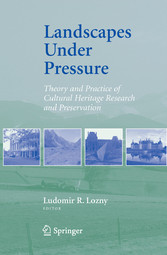Search and Find
Service
More of the content

Landscapes under Pressure - Theory and Practice of Cultural Heritage Research and Preservation
1 Place, Problem, and People: Issues in Interdisciplinary Cooperation (p. 5-6)
THOMAS H. MCGOVERN
Northern Science &, Education Center, Anthropology Department, Hunter College, CUNY
695 Park Ave. NYC 10021, naho@voicenet.com
Introduction
When Ludomir Lozny first approached NABO (North Atlantic Biocultural Organization) with a proposal for a workshop focused upon the practical problems confronting modem Polish archaeology in the 21 century (rapid economic change, EU membership, and a massively disruptive program of superhighway construction) our first reaction was that Poland was a bit out of our self-described research area and that NABO was primarily a research cooperative aimed at international, interdisciplinary collaboration (McGovem 1990,1995 ,2003). The geographic problem was not an insurmountable problem, as NABO was founded in part to draw circumpolar "arctic" researchers and funding into places historically connected to the north but located in the north temperate zone (like Scotland and S Norway). The Baltic connections to the North Atlantic fisheries alone provides a potential research link, and Polish archaeologists have played a major role in NABO projects in Norway and Iceland (notably Przemyslaw Urbariczyk, see Urbanczyk 1992). The geographical boundary expansion was thus an easy sell, and there was considerable interest expressed by several NABO members and participating institutions in a Baltic-associated conference.
More of a problem was the perceived gulf between research-oriented academics and contract-based rescue or cultural resource management archaeologists. Much has been written about the growing professional and cultural divide between "pure research" and "commercial" archaeologists, especially as a growing majority of archaeologists on both sides of the Atlantic find their major employment outside of traditional academia (see Rothschild this volume, also the Society for American Archaeology website www.saa.org for discussion and useful links). Mutual negative stereotyping has a long history, with academics derided for their unworldly approach to practical field problems and chronic failure to meet deadlines and contract workers labeled as mere technicians carrying out "paycheck archaeology" with scant regard for larger research questions or the wider perspectives of regional or world archaeology. While such stereotypes tend to have only enough truth behind them to sting (and alienate), they reflect a deeper problem that was to recur as a discussion topic in the workshop: the progressive separation of archaeological theory from archaeological practice. Theory and practice in archaeology have not always been so compartmentalized. The development of the "new" processual archaeology in the 1960's-70's was as much a set of methodological as theoretical changes. Flotation, systematic sampling, statistical analysis, and computer applications were all presented as part of an integrated package that would allow us to swiftly explain all past human behavior in terms of a few elegant law-like generalizations. The rapid development of zooarchaeology, archaeobotany, and geoarchaeology in the last quarter of the 20 century that has so transformed the organization of the discipline (and created the job I now hold as zooarchaeology lab director) owes a good deal to the processualists' somewhat ecodeterminist theoretical agenda. The accelerating impact of digital hardware and digitized data management in archaeology likewise has roots in processualist interest in quantification and statistical significance testing. The processualists' fervent ideological scientism and genuine interest in integrating natural science methods and expertise also very definitely had an impact on the current widespread acceptance of archaeology as a science for funding purposes by agencies like the US National Science Foundation (source of most large scale academic funding in current American archaeology).
These financial, organizational, and methodological transformations of the processualists' era arguably have had a more lasting impact on the way most archaeologists now do their daily work than some of their more optimistic theoretical statements (as a graduate student in the late 1970's I had genuine concern that all the good law-like generalizations would have been discovered before I was on the job market). While few of us would care to return to such a simple view of causation and human behavior, no respectable academic or contract archaeologist would seriously contemplate discarding flotation, zooarchaeology, or science-based funding opportunities. The dramatic expansion of the non-academic contract scene in the past two decades has in fact been an occasion for the full application of the new tools of the 1970's to real field situations across the world. As many observers have noted, today it is often contract firms who are most able and willing to afford investments in cutting edge survey and excavation technology and the most technologically savvy field archaeologist today has often spent most or all of her career outside of academia. In much of the world savage cutbacks, repeated retrenchments, and "jobless recoveries" have prevented any significant expansion of academic archaeology in the 1990's, thus ensuring that this technically sophisticated, highly experienced fieldworker is unlikely to eventually find herself in an academic position even if she were willing to accept the usual pay reduction involved.
All prices incl. VAT












